Kapalua – The Plantation Course
HI, USA

Who will ever forget the finish that Tiger Woods and Ernie Els put on at the thrilling Home hole during the 2000 Mercedes Championship? Great architecture does indeed inspire great golf.
If a Valhalla or a Sahalee or a Hazeltine were to contract a disastrous grass disease two weeks before hosting the PGA Championship, the authors would unreservedly put forward the Plantation Course at Kapalua as the ideal host course on short notice. No rough would need to be grown, as the course doesn’t rely on rough as part of its challenge. The course is always maintained fast and firm. It has plenty of length. And, unlike so many PGA sites in August, Hawaii offers an ideal climate for golf.
Who would the winner be of such an event? He would resemble past Masters and Open winners where imagination and playing in the elements takes precedence over the ability to hit straight shots to such narrow fairwaysas are generally associatedwith thePGA and U.S. Open championships. Someone like Seve Ballesteros perhaps.
At first glance, few peopleassociate the traditional golf design aspects of such fabled and historic coursesas Augusta National and The Old Course at St. Andrewswitha modernHawaiian resort course. However,the three courses share manysimilar design principles:50 yardplus wide fairways, large dramatic greens, little rough, greens that slope from front to back, greens that are open in front to promote the ground game and finally fascinating chipping areas.
Bill Coore and Ben Crenshaw are the architects who had the vision to design this course. Like Augusta National, the course is laid over a vast piece of property. The Plantation course sits on 240 acres of former pineapple fields. The rugged terrain presented an immense challenge, as the architects had a number of gorges and valleys with which to contend. The architects originally found the stunning 665 yard 18th and built the rest of the course around it. Nonetheless, the property was far from ideal.
A lot was at stake as Coore and Crenshaw stalked the property during 1990- a poor routing would have doomed the course as it would have left the golfer forever fighting the hillside. In the end, the architects are to be congratulated for what must qualify (along with another of their designs, Sand Hills) as one of the two or threefinest routings in the modern era, if you accept as a given that the course was never going to be too walker-friendly.
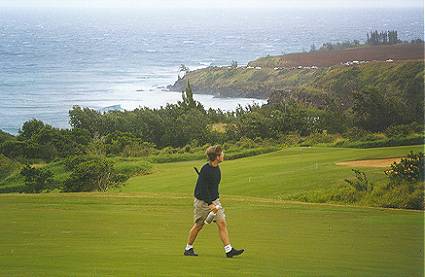
The topography at the Plantation course initially presented quite a challenge to Coore & Crenshaw. However, their routing yielded numerous unique and distinctive holes.
Given the course is laid out over the broad sweep of a hill down toward the Pacific Ocean, the property was always going to yield some spectacular downhill holes. And did the architects deliver! The glamour holes like the 475 yard 1st, 485 yard 7th, 485 yard 17th, and the 665 yard 18th are indeed unforgettable. The experience of playing them is unique to this golf course. However, what goes down, must go up and it is the quality of the uphill holes that elevate the Plantation Course from a typical resort course with four or five postcard holes to a ‘must play’ course.
The 3rd, 4th, 9th , and 10th holes are most appealing examples of uphill architecture. Combine those holes with the unforgettable stretch from the 13th tee to the 16th green where the golfer climbs 200 feet without realising it, and the golfer appreciates he is witnessing the work of the finestdesign team in golf today.
The green sites make the uphill holes. The 4th green features the most imaginative interior contours on the course. The 10th and 13th greens are perched on top of knolls which shrug balls away. As an exampleThe author paced off that his ball rolled thirty-seven yards off the 10th green and well back into the fairway. A similar event happened to the other author on the 15th hole as his attempt to reach the green in two just failed. To watch the slow roll of the white ball against the green turf for forty yards or so is an enjoyable frustration that is all but gone from most courses built in the past 50 years.
The view from each hole is notdwelled uponin the Holes to Note section becausesuperlatives would run out. Suffice to say, the golfer has a clear view of the next door island Molokai and the Pacific with its whitecaps from every hole with whale watching apotential distraction. Also, the normalone to twoclub trade wind that blows down off the mountain has been assumed in the descriptions below.
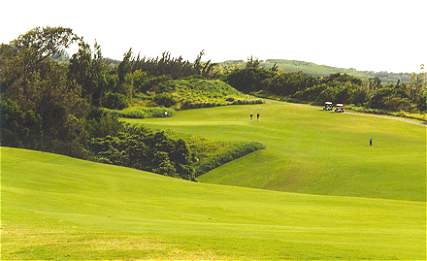
The elusive 15th green – the player’s ball on the right at one point was within five yards of the green before rolling down the hill.
Holes to Note:
1st hole, 475 yards: Sounds tough? Welcome to the Plantation Course at Kapalua where distance means little. The hole plays downhill, downgrain and down wind with afairway whose immense width makes the 1st fairway at Royal Melbourne (West) look tight. The mid to short iron approach shot is across a valley to a vast green that is open in front.
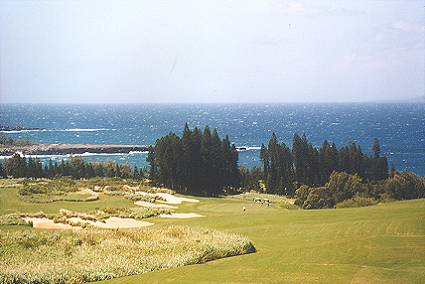
Note how well the large bunkers are integrated into their surrounds.
5th hole, 530 yards: A fine example of a hole that gives options.Some prefer to hug the right side of the fairwayas it affords the shorter route home on this reachable three shotter. However, the right side is the home to a 300 foot (!) gorge. Others prefer to takethe tee ball up the safer left hand side of the fairway. From there, the approach shot iswith the ball below one’sfeet but that is desirableas the slope will assist him hit a fade into the greenthat isopen on its left side. Thus, shots hit with a fade will take the graceful left to right fairway slope by the green andfeed onto it. Far too many modern courses only accept one style of play. This is emphatically and most refreshingly not the case at the Plantation course.
7th hole, 485 yards: The front to back green races away from the golfer. Watching a six iron hit from 220 yards away land 20 yards short of the green, then bound toward the green and slowly, ever so slowly rolltoward the back hole locations is a delight. As with the 18th, the player feels it is impossible for his approach to stop short of the hole.
8th hole, 200 yards: The hole consists of a tee and a green surrounded by bunkers. In between, there is a deep gorge (this and the 17th have the only forced carries on the course). The winds tend to swirl down at this bottom part of the course. A high tee ball is a hit and hope shot. The golfer needs to control the flight of the ball if there is any wind about. The green is steeply pitched from back to front, so the smart player appreciates that the green plays almost twice as deep as its measurements indicate. The more you play it, the harder it seems to get.
9th hole, 520 yards:Either abrute ora birdie hole, depending on the strength of the wind, avalley bisects the fairway at the 300 yard mark. To carry to the far side of the valley is 380 yards from the tee but into the wind, it takes two animalistic shots to do so. The hole plays equally well in any wind. The green sits on its own little plateau. Many architects would have framed it with bunkers around the back. These bunkers would in fact be nothing more than eye candy. As Coore/Crenshaw have it, there are no bunkers. The green and its surrounds appear inviting. However, once the golfer gets above the hole, he will begin to realize he has been sucked in. Like the 8th green, this one is pitched from back to front, and the player seems inevitably always to be above the hole.
11th hole, 165 yards: A beautifully simple hole. The normal trade winds blow from right to left across this green. The green is open front right. The front left of the green is bunkered as is the length of the right side. The golfer can hold the ball back into the wind or bounce a running shot onto it. However, when the flag is back left, a high shot that starts right of the green and drifts with the wind is most appealing to watch.
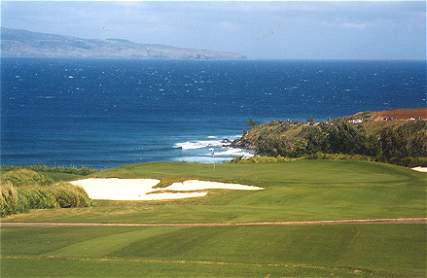
The electric blue water of the Pacific Ocean provides a backdrop to the 11th green that is almost too vivid to believe.
13th hole, 405 yards: The longest 400 yards in golf. The same power fade that would cover 350 yards on the 7th hole would leave a golfer with a long iron into this green. The green itself is vicious. Following the contours of the land, it slopes hard from back to front and from right to left. This is the hardest hole on the course.
14th hole, 305 yards: A great example of a change of pace hole, sandwiched in between a tough uphiller and a par five. This hole features by far the smallest green on the course at only 3500 square feet, compared to the other greens that average over 10,000 square feet. The green is placed on a small plateau. Playing a short iron in windy conditions is tricky business, and this no exception with such small room for error.
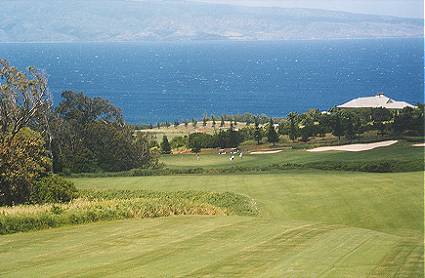
The dramatic 17th starts one of golf’s finest finishes
17th hole, 485 yards: Broadly speaking, this hole is similar to the 18th hole at Harbour Town if that hole were laid down a ski slope. The fairway is 100 yards (!) wide. The golfer seeking the shorter way home must play over a deep gorge to a green the size of a small colony. Watching a well-played approach drift across the green from right to left toward the hole is satisfying indeed.
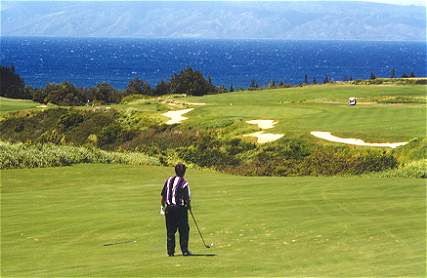
The thrilling 18th – 290 yards out and still going for it in two!
18th hole, 665 yards: Believe it or not, this is a gambling three shottereven though it is 200 yards longer the 13th hole at Augusta National. How far downhill, down wind is it?In a shot that he will remember forever,my (then) sixtyone year old father reached the edge of the green from 315 yards out! As has been noted throughout these course profiles, this type of hole where big swings are possible (anything from a 3 to a8 awaits) is theauthor’s favorite type finishing hole.Just hitting this 16,000 square foot green from just 30 yards short of it in the fairway is one of the single most demanding shots on the course, all because of the front to back tilt of the green.
Just like the original links courses, playing Kapalua is a classic experience of man vs nature on a grand scale. The course was designed with big features in mind to accept the variable of slope and wind that are predominant. To complete the experience, caddies are available on weekends. Listen to them. In fact, if the golfer is after wind and hard running conditions, he ought to strongly consider this course as an end destination as opposed to what are becoming over-watered links courses in the U.K.
The flexibility of the course is perhaps its most enduring feature. Its wide fairways will assist the most modest golfer around the course. However, there is always an advantage to be gained for the better player, whether it is a level stance or a better angle into the green. Virtually every other new course built over similar rugged terrain is a ‘two sleeve’ course with little strategic merit. The design of the Plantation course adheres to the lessons learned from St. Andrews and Augusta National on makinga course challenging to all levels; the need to look for golf balls is virtually unknown at all three courses. How refreshing.
The End

